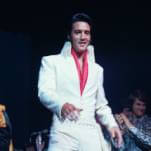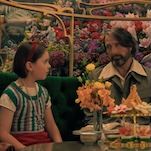That’s one of the differences with scripted TV. I worked on background on 30 Rock, which means I’d dress the people in the background on the shot. 30 Rock kind of wanted to suggest a backstage crew, so a lot of the same background people were in the show over and over again, but some people you’d see once and never see them again. I would try, at least, to not treat them like scenery, which is what a lot of people think background actors are. And I guess they are a little bit, but they are actors and they are doing a job. I’d try and get to know their names so they wouldn’t just be faceless people in the background.
And of course, there are no quick changes in scripted shows since the actors have the time to get dressed and there are craft services where they can take care of themselves.
AVC: Once you have a job somewhere you dress the same person each show?
KS: Yes. You’ll stay on the same track for as long as you’re there, or for as long as your person is. Sometimes an actor will request you and you’ll follow him from show to show, or you’ll stay and get a new person. When I was at SNL I dressed Bobby Moynihan for three years; I was his person. It’s nice how a lot of the same people stay there over the years. Kenan’s [Thompson] dresser has been with him since the beginning. The gentleman who dressed Kristen Wiig now dresses Kate McKinnon.
Right now I’m at Gigi, dressing Corey Cott and Howard McGillin. If the show runs awhile and one of them were to leave, I would dress that replacement also. It’s important to stay on the same track because you really get into a routine. After a while, the actor knows when to lift his arms or feet during a quick change and you know how to change him. On SNL you don’t have time to rehearse and get a routine, but you develop a relationship with the actor and that’s important, both for trust and to develop a shorthand.
AVC: Is there a rule about male dressers only dressing men?
KS: Not really, but I think there’s only been one show where I dressed an actress: Catered Affair, where I dressed Leslie Kritzer. If the actor doesn’t have a problem with it, there’s no problem. Some actors even want a female dresser and some actresses want a male one. Sutton Foster has a guy who has done every show with her; it just depends on what makes the actor comfortable.
AVC: How quick is a quick change?
KS: We can do a total change from one big costume to another, with wig and makeup changes, in 45 seconds. It’s kind of like a Nascar pit crew.
AVC: What has to happen for one to run smoothly?
KS: The actor has to be calm. Calm, calm, calm. And just help as much as they can. The worst thing they can do is freak out or panic that they’ll miss their cue. It is much easier for them to just stand still rather than panic and scream, “Hurry up!” Newbies, generally speaking, tend to freak out more, but once they get used to the speed and time pressure they calm down. They get what needs to happen, and know they have to help as much as possible.
On my side of things, at SNL, we have racks with all the costumes the actor will be wearing that show, so I’ll already have the next one ready. I’ll have the pants on the floor, puddled in a pile, so they’d drop one pair and just step over into the other one and pull them up. While they’re doing that, you’re taking the top part of their costume off.
At SNL everyone has both a wardrobe person and a hair and makeup person. It’s a tag-team if I need to change clothing and they need to change a wig or add a mustache. It can get really complicated if the space is small or the costume is big, or if the actor is tall, because then you need a step ladder just to reach them. One dresser does the hosts; she’s of average height, but if there’s an athlete hosting, those guys are just enormous. They tower over her. So that’s rough, especially since the hosts often have the most or quickest changes because they’re probably in every sketch.
This all really depends on the show. If my guy is doing two sketches back-to-back, but in the second one he’s standing behind a bar where you can’t see his bottom half, we’ll just change the shirt and not worry about the pants. He could have totally odd pants on for the character but you’d never know.
In Little Me, Marty played nine different characters and had to go back and forth between them. Sometimes he would have up to three costumes layered on top of each other; he would peel one off, peel another off, snap one on, whatever. That was one of the harder shows I’ve done. Not only were we getting him in and out of things, but there was a wig person there putting him in something new at the same time. It’s choreography, really. It’s as much choreography as what’s being done onstage.
AVC: You don’t have time to go back to the dressing rooms.
KS: No, and sometimes it can be tough to find a place to do it. With more time you can go to a changing station, but if you only have a minute between scenes or sketches you just have to find a place. I did Rocky on Broadway last year and dressed Andy Karl, who played Rocky. The set there was massive, just massive, with tons of pieces squeezed into the theater, which meant there were times when we had maybe a foot and a half in which to change him. Sometimes you might even change onstage; you’d be on it while the set is moving and transitioning into a new scene. That’s a big part of tech rehearsals for me, figuring out where we need to go to do things.
On SNL, if we’re not doing it right there off to the side of the set, there are certain spots that an actor knows to go to after a sketch for a change. There are a bunch of little stages set up; one of them is called “Paint Cans,” where the wall has all these cans of paint. It’s very clever. You’ll tell the actor to go there after the sketch, or you’ll go to the set and grab them and take them there as fast as you can to change them as fast as you can.
AVC: Is the clothing modified?
KS: A lot of it is rigged. Some of it just has big zippers that go right up the back, or there are snaps that just pull apart. Men’s ties are usually pre-tied, but sometimes we’ll use clip-ons or ones that snap together in the back. We’re not unbuttoning one shirt and then buttoning up another one.
AVC: For changing pants quickly, is there a type of underwear that’s easier for a man to be wearing so it doesn’t bunch up?
KS: No, not really. On Broadway, men sometimes prefer dance belts, which offer more protection, or Under Armour, which fits tighter and means the mic won’t bounce around. But otherwise, unless it’s part of the costume, they wear what they want.
AVC: Do you consult with the costume designer to say how an outfit needs to be rigged?
KS: Not usually. If we need something altered we’ll go to the wardrobe supervisor and ask if we’re able to make that alteration. Some designers don’t like their costumes rigged; they want it to appear as real as possible, in which case you do what you can. You tell them, “Okay, we’ll just get these buttons up as fast as we can.”
AVC: You mentioned getting into a routine when you do theater, do you have enough time to develop a routine for each episode of SNL?
KS: We have less than a day. We’re called in at noon on Saturdays; that’s the first time we see the costumes we’ll be working with that night. A lot of the standard clothing, like shirts, are rigged in the same way, so that’s not something we need to learn, but we have to make time to familiarize ourselves with everything in case we have unusual ones.
AVC: SNL must have some unusual costumes.
KS: Oh yeah, big foamy things. I remember Bobby played Gonzo in a Muppets sketch one time, which was difficult. Another time—and this was probably the hardest costume we had to put on him—he played a 500- or 600-pound man. It was a sweat suit just full of foam and stuffing. It was incredibly tricky to get it on him, and then to get him to the set, because it was hard for him to move in it. Not only that, but he was wearing a fat face and a bald cap. Another time he played a bagel, and there was a quick change to get him in and out of that, which was a whole ordeal. We were just praying it was going to work.
AVC: Where do those costumes come from?
KS: The stuff you can’t find at stores is made by a guy at SNL. Justin Timberlake’s omelet, for one, is a speciality job. Now, when your guy is doing a sketch where he has to wear something like that, you can examine it ahead of time to see how to dress someone in it. Will he need to hold their arms up while you slip it over him? Is there velcro? The costume people try to finish those early so the actor can rehearse in them and know, for example, how much he’s able to move his arms. If he needs to, the gentleman who makes them can cut out some foam or do something to make it better for the actor and for changes. SNL uses a lot of real clothes, which it just goes out and buys, but obviously after 40 years it has a huge stockpile, so if the script calls for overalls or a spacesuit they probably have it, and if they have it, it’s probably already rigged.
AVC: Where is the microphone?
KS: On Broadway the actors have mic packs on elastic bands, which the girls will sometimes have under their wig and the boys will often have the packs sewn into the backs of their underwear. I don’t really deal with that; the actor will place it and then the sound department will come by to confirm it’s working properly. If the actor appears without his shirt, the wire might be taped up his back, but it’s flesh-colored, so you wouldn’t see it. In the big fight at the end of Rocky we took the mics off the actors completely because we didn’t want to risk a punch pulling out a wire. What we did there was, we had a mic hidden in a towel around Rocky’s shoulders for his dialogue.
If a costume covers part of the actor’s face at SNL, there will probably be a mic hidden on them somewhere just to make sure that they can be heard, but otherwise the show uses boom mics, and thank God, because otherwise that would be another huge thing for us to worry about. There are microphones on “Weekend Update,” anything at the SNL news desk, but they’re just basic ones attached at the lapel.
AVC: What’s your rehearsal process like at SNL? You said you’re in at noon?
KS: Yes. The actors come in around 12:30 and do every skit. They’re in their costumes then, and that’s when the show finds out what works or doesn’t, and when we find out if there’s anything we have to fix or rig up with velcro.
The first dress rehearsal with a live audience is at 8 p.m. That’s a two-hour show, and after that the producers will cut it down to an hour and a half depending on what’s funny and what’s not, though sometimes an unfunny sketch will stay in if the host is in it. Our rigging and plans for where we’ll do the quick changes are based on the first show, but depending on what gets cut, all your sketches may be gone in the live one. From 8 to 10 the show is one thing; at 11:30 it’s totally different. It’s really like doing two completely different shows back-to-back, and the producers actually keep tweaking it while it’s on the air. If the show is running long, a sketch might get dropped or lines may get cut for time, so it’s possible that your actor’s part will be gone. Because of that, we try not to go too far ahead and get them dressed for a sketch that’s several down the line. It may end up not happening.
AVC: Is it stressful?
KS: It can be incredibly hectic. You may have four sketches back-to-back and you just have to find a way to do it. You need to schedule your bathroom breaks, and if you miss one, sorry. You can’t pee.
Of course, it may be frantic, or it may work out where you can have one sketch the whole night or all your sketches are spaced out so you don’t have any quick changes. The nice thing about SNL is that if your actor is only in three sketches and they’re all in the first half-hour, then after that you’re done. You leave. Of course, you may have a week where you’re working the first sketch and the last sketch and you’re just hanging around in between. Each actor has a dressing room that’s a bit removed from the stage, but they also have these little booths, no bigger than 6 by 6 [feet], where they do a lot of their changes if they don’t have to do a quick change right offstage. That’s where the dressers usually hang out. There are chairs and we can sit and watch the show on monitors.
It can be rough, but that’s why I love it. I love that each show is different and that each has its own challenges. And it’s not like your person is in nine sketches. Usually your person is in four or five, and there are stretches like commercials or “Weekend Update” where you may not have anything going on. Digital shorts are actually incredibly useful for us; they only run two or three minutes, but that’s luxury for a change at SNL.
AVC: Have you ever missed a cue?
KS: I have never missed a cue, knock on wood. I have gotten the actor there at the very last second, running as fast as I could, but I have never missed one and I hope I never will. Sometimes, frankly, there’s just not enough time, but that’s what rehearsal is for, or what tech is for on Broadway. That’s when the show learns whether it needs to add lines or a little music to give people a few extra seconds. Sometimes there’s just no way to do one sketch after another, so they might get reordered to ease that.
AVC: Do wardrobes malfunction?
KS: There’s always something. Something will tear or a zipper will get stuck. I have a toolbelt on me at all times with safety pins and a threaded needle, everything I need to fix things right away if possible. If a shoelace breaks we have elastic bands to put around the actor’s foot and keep the shoe on; that usually works unless it’s a dance-y number. Sometimes we just sew the person into the costume and worry about it when they come off.
As far as real disasters, I remember one time on SNL dressers were getting actresses into dresses and they had to do it—super quick. One of the dresses had a bunch of loops on it, and the poor girl who was dressing the actress accidentally got a foot stuck in one of the loops. When she was trying to get it out an arm loop got messed up, and while they were fixing that the wig person was trying to get the wig on and that got tangled. Eventually the actress had to go out with the dress literally hanging off of her on one side, while it was pretty much her slip on the other side. Would you know it, watching on TV? I don’t think so, but offstage everyone knew.
Another time I was dressing Bruce Vilanch, who was doing Hairspray. He comes out in this beautiful skirt, and as the scene goes on the skirt just starts sliding slowly down his waist, lower and lower, until it ends up around his ankles. Luckily he’s a comedian, so he just picked it up, put it over his shoulder, made some crack, and then just did the rest of the scene normally.
Stuff happens, just as it does in real life, where you’re liable to pop a button. The clothes are normal clothes; they aren’t always reinforced, and depending on the show they can undergo a lot of wear and tear. I just did the musical On The Town, and those kids danced so hard, crotches ripped out. You do what you can do.
AVC: If a costume gets stuck during a quick change, do you just tear it off?
KS: If it’s the live show of SNL that wouldn’t be a problem, but obviously in the dress rehearsal you’ll need it again in a few hours. In some cases there will be three or four sets of a costume, especially if it’s going to get wet or have fake blood or gunk on it, so there may be spares, but otherwise if a zipper gets stuck we’ll just tear it open and hope we’ll have time to fix if it.
AVC: Is it your job to fix it?
KS: SNL always has two or three stitchers on duty, so you’ll call one over if you need to. And all of us have basic sewing skills. Here at Gigi, if something rips there’s a room in the basement of the theater with sewing machines and a washer/dryer, everything you would need to maintain or fix a costume.
AVC: How did you get into this?
KS: I went to college to get an acting and directing degree, but I also did a lot of costume stuff and behind-the-scenes stuff. At the time my main goal was to be an actor, and I got hired to do dinner theater in Lancaster, Pennsylvania. The first week I was there they fired the costume designer and they asked me to do it since I had costume background. I did it, then they asked me to do the next show, so I did that, then they asked if I would stay around and be their resident costume designer. I said yes so long as I could still be an actor, so for the next five years I was an actor-slash-costume designer.
At one point they decided to open a theater in Fort Myers, Florida, so I went down there for four years. There’s where I met my husband, Russell. That got to be kind of a bad track; once you’ve done My Fair Lady four times you’re ready for a change. So Russell and I moved to New York in 1997. I went to a couple auditions, but acting wasn’t my bag anymore.
Around that time I was asked to do one more show in Pennsylvania, and there I met another guy who was in acting-slash-costumes, and he gave me the number of someone in New York who needed “day work” done for the musical Sideshow. That’s when you come in to prep everything for the night’s show. That’s where I started. Eventually I got my union card, and when I went to Little Me they asked me to dress Marty because we were about the same age and they figured he and I would get along better than he would with a 20-year-old dresser. They were right.
I’ve been very fortunate. I dressed Harvey Fierstein in Hairspray for two and a half years, then after that Michael McKean, Bruce Vilanch. Michael McKean knew I was getting tired of Hairspray, so he made a call to Tim Curry, who at the time was doing Spamalot. Michael, God bless him, asked Tim to hire me as his dresser; he did, and I was there for three years. I did Newsies with Jeremy Jordan, which is where I met Corey, who eventually asked me to come here and dress him at Gigi. Because of that, I stopped doing SNL. I don’t feel that it’s right to take off Saturdays to do another job when an actor asks you to be their person. I’d love to go back someday, though.
AVC: When did you get started at SNL?
KS: In 2000. I was sending my resume out and Dale Richards, the costume supervisor, randomly called me in for an interview to dress background. I did that for a couple of shows and they asked if I could do featured players. I did Fred Armisen for a while, I dressed Seth Meyers. Jerry Minor, though I think he was only there for a season.
I tossed between Broadway and TV for a while, and one time when I came back they told me about Bobby, who is just the nicest guy on the face of the planet. I was there his first season and he was like a kid in a candy store. I’m the same way. I’ve been doing this 18 years, and I’m still like, “Am I really here?” I’m from a tiny redneck town in southern Illinois and sometimes I just can’t believe I’m now doing this for a living. I mean, the people I’ve met! The people I’ve dressed! When I met Marty, he was the first celeb I had ever met in my life. During the run of the show, Marty would say, “There are some people here, can you go get my guests?” I’d go, and in come the Spielbergs, the Tom Hankses and Goldie Hawns. When people in my hometown hear about my job they always think it’s so glamorous, and it is, but I want to be modest, so I’m always sure to tell them that at the end of the day, I’m the one who winds up with a basket of dirty underwear.








































